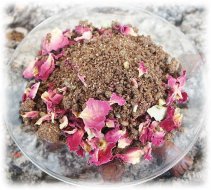
The romance of the past drives many of us to seek out ancient fragrances — antique recipes and perfume formulas that have been resurrected for modern-day use. Egypt casts a spell on fragrance lovers, with its aromas of lotus, mint, papyrus, spices and resins. Add these aromas to images of pyramids and imposing sculptures of the gods, chanting priests (who would recite religious texts while mixing incense), pharaohs and queens, glittering scarabs, gaping-mouthed mummies grasping gold and lapis lazuli scepters between fragile bony fingers, and you have a heady mix of sight, sound and scent.
First mentioned in the Pyramid Texts (dated 2400 BCE or earlier), the recipe for kapet (or kyphi in Greek, meaning “welcome to the gods”) was also mentioned by Plutarch (c 46-127 CE) and Galen (129-200 CE) in their writings — linking kyphi with religious ritual and with medicinal uses. Instructions for the preparation of kyphi are found on wall inscriptions at the temples of Edfu and Dendera…